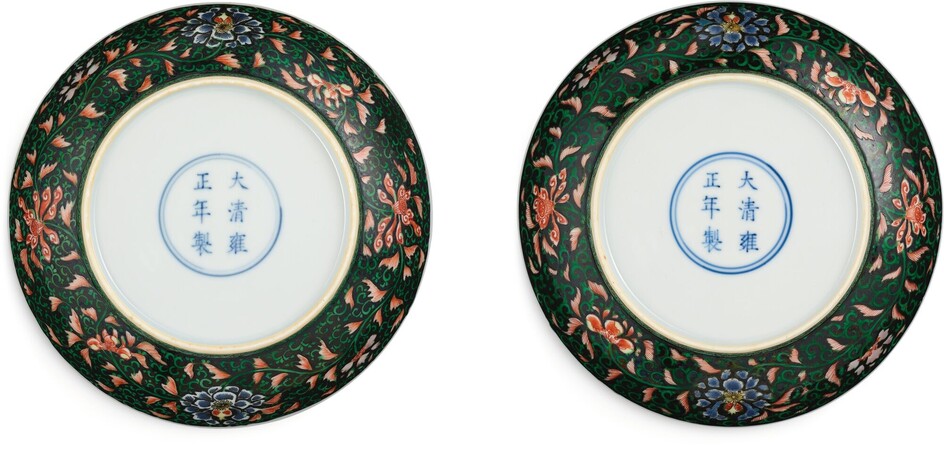A RARE PAIR OF FAMILLE-NOIRE 'FLORAL' DISHES MARKS AND PERIOD OF YONGZHENG
each with shallow rounded sides rising from a tapered foot, the exterior vividly enamelled against a lustrous black ground, depicting alternating iron-red lotuses and blue peony blooms borne on undulating leafy scrolls and tendrils, all above a band of black-pencilled classic scroll against a light green wash skirting the foot, the base inscribed with a six-character reign mark within a double circle
14.8 cm, 5 7/8 in.
Provenance:
The current pair of dishes, with the striking iridescent black ground, belongs to a small, rare group of famille-noire wares produced in the Yongzheng period. Not only do they reflect the Emperor’s tendency of harking back to celebrated wares of the past, they also demonstrate the craftsmen’s high level of experimentation and ability to go above and beyond.
The colour scheme first appeared on a small number of pieces produced in the mid-15th century, whereby a layer of lead-based copper-green enamel was combined under a layer of cobalt, which upon firing, fused them together to create a glossy black glaze. Revived under the Kangxi reign as an extension of the famille-verte palette, vessels were enamelled with decoration against a black ground. See a pair of bowls vibrantly enamelled with floral scrolls against a black ground, dated to the Kangxi period, from the Avery Brundage Collection and now preserved in the Asian Art Museum of San Francisco, published on the Museum’s website, nos B60P1742 and B60P1743.
By the Yongzheng period, the porcelain body became finer, thus enabling the black enamel to achieve a glossier and more iridescent effect as seen on the present pair of dishes. Despite the remarkable contrast from setting coloured enamels against a black ground, such wares and identical pieces are extremely rare due to the difficulties in producing them.
For closely related examples, see one in the Shanghai Museum, illustrated in Zhongguo meishu quanji. Gongyi meishu bian: Taoci [Complete series on Chinese art. Arts and crafts section: Ceramics], Shanghai, 1988-1991, vol. 3, pl. 202; another in the Victoria and Albert Museum, London, gift of Julia C. Culland, illustrated in Rose Kerr, Chinese Ceramics, Porcelain of the Qing Dynasty 1644-1911, London, 1986 (rev. ed. 1998), no. 23; and a pair sold in these rooms, 8th October 2019, lot 3020.
View it on
Estimate
Time, Location
Auction House
each with shallow rounded sides rising from a tapered foot, the exterior vividly enamelled against a lustrous black ground, depicting alternating iron-red lotuses and blue peony blooms borne on undulating leafy scrolls and tendrils, all above a band of black-pencilled classic scroll against a light green wash skirting the foot, the base inscribed with a six-character reign mark within a double circle
14.8 cm, 5 7/8 in.
Provenance:
The current pair of dishes, with the striking iridescent black ground, belongs to a small, rare group of famille-noire wares produced in the Yongzheng period. Not only do they reflect the Emperor’s tendency of harking back to celebrated wares of the past, they also demonstrate the craftsmen’s high level of experimentation and ability to go above and beyond.
The colour scheme first appeared on a small number of pieces produced in the mid-15th century, whereby a layer of lead-based copper-green enamel was combined under a layer of cobalt, which upon firing, fused them together to create a glossy black glaze. Revived under the Kangxi reign as an extension of the famille-verte palette, vessels were enamelled with decoration against a black ground. See a pair of bowls vibrantly enamelled with floral scrolls against a black ground, dated to the Kangxi period, from the Avery Brundage Collection and now preserved in the Asian Art Museum of San Francisco, published on the Museum’s website, nos B60P1742 and B60P1743.
By the Yongzheng period, the porcelain body became finer, thus enabling the black enamel to achieve a glossier and more iridescent effect as seen on the present pair of dishes. Despite the remarkable contrast from setting coloured enamels against a black ground, such wares and identical pieces are extremely rare due to the difficulties in producing them.
For closely related examples, see one in the Shanghai Museum, illustrated in Zhongguo meishu quanji. Gongyi meishu bian: Taoci [Complete series on Chinese art. Arts and crafts section: Ceramics], Shanghai, 1988-1991, vol. 3, pl. 202; another in the Victoria and Albert Museum, London, gift of Julia C. Culland, illustrated in Rose Kerr, Chinese Ceramics, Porcelain of the Qing Dynasty 1644-1911, London, 1986 (rev. ed. 1998), no. 23; and a pair sold in these rooms, 8th October 2019, lot 3020.



